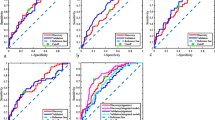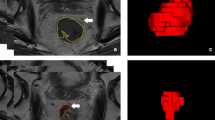Abstract
Objective
To develop a T2-weighted (T2W) image-based radiomics signature for the individual prediction of KRAS mutation status in patients with rectal cancer.
Methods
Three hundred four consecutive patients from center I with pathologically diagnosed rectal adenocarcinoma (training dataset, n = 213; internal validation dataset, n = 91) were enrolled in our retrospective study. The patients from center II (n = 86) were selected as an external validation dataset. A total of 960 imaging features were extracted from high-resolution T2W images for each patient. Five steps, mainly univariate statistical tests, were applied for feature selection. Subsequently, three classification methods, i.e., logistic regression (LR), decision tree (DT), and support vector machine (SVM) algorithm, were applied to develop the radiomics signature for KRAS prediction in the training dataset. The predictive performance was evaluated by receiver operating characteristics curve (ROC) analysis, calibration curve, and decision curve analysis (DCA).
Results
Seven radiomics features were screened as a KRAS-associated radiomics signature of rectal cancer. Our best prediction model was obtained with SVM classifiers with AUC of 0.722 (95%CI, 0.654–0.790) in the training dataset. This was validated in the internal and external validation datasets with good calibration, and the corresponding AUCs were 0.682 (95% CI, 0.569–0.794) and 0.714 (95% CI, 0.602–0.827), respectively. DCA confirmed its clinical usefulness.
Conclusions
The proposed T2WI-based radiomics signature has a moderate performance to predict KRAS status, and may be useful for supplementing genomic analysis to determine KRAS expression in rectal cancer patients.
Key Points
• T2WI-based radiomics showed a moderate diagnostic significance for KRAS status.
• The best prediction model was obtained with SVM classifier.
• The baseline clinical and histopathological characteristics were not associated with KRAS mutation.






Similar content being viewed by others
Abbreviations
- 3D:
-
Three-dimensional
- ANOVA:
-
Analysis of variance
- ARMS:
-
Amplification-refractory mutation system
- AUC:
-
Area under the ROC curve
- CA199:
-
Carbohydrate antigen-199
- CEA:
-
Carcinoembryonic antigen
- CRC:
-
Colorectal cancer
- DCA:
-
Decision curve analysis
- DKI:
-
Diffusion kurtosis imaging
- DT:
-
Decision tree
- DWI:
-
Diffusion weighted imaging
- EGFR:
-
Epidermal growth factor receptor
- FFPE:
-
Formalin-fixed, paraffin-embedded
- GLCM:
-
Gray-level co-occurrence matrix
- GLDM:
-
Gray-level dependence matrix
- GLRLM:
-
Gray-level run length matrix
- GLSZM:
-
gray-Level size zone matrix
- IVIM:
-
Intravoxel incoherent motion
- KRAS:
-
Kirsten rat sarcoma
- LoG:
-
Laplacian of Gaussian
- LR:
-
Logistic regression
- LVI:
-
Lymphangiovascular invasion
- MRI:
-
Magnetic resonance imaging
- NCCN:
-
National Comprehensive Cancer Network
- PACS:
-
Picture archiving and communication system
- pCR:
-
Pathological complete response
- PCR:
-
Polymerase chain reaction
- RBF:
-
Radial basis function
- ROC:
-
Receiver operating characteristic
- ROI:
-
Regions of interests
- SVM:
-
Support vector machine
- T2W:
-
T2-weighted
- VOI:
-
Volume of interest
References
Siegel RL, Miller KD, Jemal A (2019) Cancer statistics. CA Cancer J Clin 69:7–34
Arnold M, Sierra MS, Laversanne M, Soerjomataram I, Jemal A, Bray F (2017) Global patterns and trends in colorectal cancer incidence and mortality. Gut 66:683–691
Lievre A, Bachet JB, Boige V et al (2008) KRAS mutations as an independent prognostic factor in patients with advanced colorectal cancer treated with cetuximab. J Clin Oncol 26:374–379
Sorich MJ, Wiese MD, Rowland A Kichenadasse G, McKinnon RA, Karapetis CS (2015) Extended RAS mutations and anti-EGFR monoclonal antibody survival benefit in metastatic colorectal cancer: a meta-analysis of randomized, controlled trials. Ann Oncol 26:13–21
Heinemann V, von Weikersthal LF, Decker T et al (2014) FOLFIRI plus cetuximab versus FOLFIRI plus bevacizumab as first-line treatment for patients with metastatic colorectal cancer (FIRE-3): a randomised, open-label, phase 3 trial. Lancet Oncol 15:1065–1075
Allegra CJ, Rumble RB, Hamilton SR et al (2016) Extended RAS gene mutation testing in metastatic colorectal carcinoma to predict response to anti-epidermal growth factor receptor monoclonal antibody therapy: American Society of Clinical Oncology Provisional Clinical Opinion Update 2015. J Clin Oncol 34:179–185
Watanabe T, Kobunai T, Yamamoto Y et al (2011) Heterogeneity of KRAS status may explain the subset of discordant KRAS status between primary and metastatic colorectal cancer. Dis Colon Rectum 54:1170–1178
Sundstrom M, Edlund K, Lindell M et al (2010) KRAS analysis in colorectal carcinoma: analytical aspects of pyrosequencing and allele-specific PCR in clinical practice. BMC Cancer 10:660
Jo SJ, Kim SH (2019) Association between oncogenic RAS mutation and radiologic-pathologic findings in patients with primary rectal cancer. Quant Imaging Med Surg 9:238–246
Shin YR, Kim KA, Im S, Hwang SS, Kim K (2016) Prediction of KRAS mutation in rectal cancer using MRI. Anticancer Res 36:4799–4804
Xu Y, Xu Q, Sun H, Liu T, Shi K, Wang W (2018) Could IVIM and ADC help in predicting the KRAS status in patients with rectal cancer? Eur Radiol 28:3059–3065
Cui Y, Cui X, Yang X et al (2019) Diffusion kurtosis imaging-derived histogram metrics for prediction of KRAS mutation in rectal adenocarcinoma: Preliminary findings. J Magn Reson Imaging 50:930–939
Gillies RJ, Kinahan PE, Hricak H (2016) Radiomics: images are more than pictures, they are data. Radiology 278:563–577
Huang YQ, Liang CH, He L et al (2016) Development and validation of a radiomics nomogram for preoperative prediction of lymph node metastasis in colorectal cancer. J Clin Oncol 34:2157–2164
Cui Y, Yang X, Shi Z et al (2019) Radiomics analysis of multiparametric MRI for prediction of pathological complete response to neoadjuvant chemoradiotherapy in locally advanced rectal cancer. Eur Radiol 29:1211–1220
Liu H, Zhang C, Wang L et al (2019) MRI radiomics analysis for predicting preoperative synchronous distant metastasis in patients with rectal cancer. Eur Radiol 29:4418–4426
Zhou X, Yi Y, Liu Z et al (2019) Radiomics-based pretherapeutic prediction of non-response to neoadjuvant therapy in locally advanced rectal cancer. Ann Surg Oncol 26:1676–1684
Yang L, Dong D, Fang M et al (2018) Can CT-based radiomics signature predict KRAS/NRAS/BRAF mutations in colorectal cancer? Eur Radiol 28:2058–2067
Oh JE, Kim MJ, Lee J et al (2019) Magnetic resonance-based texture analysis differentiating KRAS mutation status in rectal cancer. Cancer Res Treat. https://doi.org/10.4143/crt.2019.050
Miles KA, Ganeshan B, Rodriguez-Justo M et al (2014) Multifunctional imaging signature for V-KI-RAS2 Kirsten rat sarcoma viral oncogene homolog (KRAS) mutations in colorectal cancer. J Nucl Med 55:386–391
Meng X, Xia W, Xie P et al (2019) Preoperative radiomic signature based on multiparametric magnetic resonance imaging for noninvasive evaluation of biological characteristics in rectal cancer. Eur Radiol 29:3200–3209
van Griethuysen JJM, Fedorov A, Parmar C et al (2017) Computational radiomics system to decode the radiographic phenotype. Cancer Res 77:e104–e107
Kramer AA, Zimmerman JE (2007) Assessing the calibration of mortality benchmarks in critical care: the Hosmer-Lemeshow test revisited. Crit Care Med 35:2052–2056
DeLong ER, DeLong DM, Clarke-Pearson DL (1988) Comparing the areas under two or more correlated receiver operating characteristic curves: a nonparametric approach. Biometrics 44:837–845
De Cecco CN, Ganeshan B, Ciolina M et al (2015) Texture analysis as imaging biomarker of tumoral response to neoadjuvant chemoradiotherapy in rectal cancer patients studied with 3-T magnetic resonance. Invest Radiol 50:239–245
Shayesteh SP, Alikhassi A, Fard Esfahani A et al (2019) Neo-adjuvant chemoradiotherapy response prediction using MRI based ensemble learning method in rectal cancer patients. Phys Med 62:111–119
Kanzaki R, Higashiyama M, Oda K et al (2011) Outcome of surgical resection for recurrent pulmonary metastasis from colorectal carcinoma. Am J Surg 202:419–426
Wu Q, Wang S, Chen X et al (2019) Radiomics analysis of magnetic resonance imaging improves diagnostic performance of lymph node metastasis in patients with cervical cancer. Radiother Oncol 138:141–148
Emblem KE, Pinho MC, Zollner FG et al (2015) A generic support vector machine model for preoperative glioma survival associations. Radiology 275:228–234
Polan DF, Brady SL, Kaufman RA (2016) Tissue segmentation of computed tomography images using a random Forest algorithm: a feasibility study. Phys Med Biol 61:6553–6569
Zhang B, Tian J, Dong D et al (2017) Radiomics Features of multiparametric MRI as novel prognostic factors in advanced nasopharyngeal carcinoma. Clin Cancer Res 23:4259–4269
Funding
This study was supported by the National Key Research and Development Program of China (No. 2017YFC0109003), the Special Research Program of Shanghai Municipal Commission of Heath and Family Planning on medical intelligence (No. 2018ZHYL0108), Shanghai Sailing Program (19YF1433100), the Science and Technology Project of Shanxi Province (No. 20150313007-5), and Applied Basic Research Programs of Shanxi Province (Grant No. 201801D121307 and 201801D221390). The funders had no role in study design, data collection and analysis, decision to publish, or preparation of the manuscript.
Author information
Authors and Affiliations
Corresponding authors
Ethics declarations
Guarantor
The scientific guarantor of this publication is Dengbin Wang.
Conflict of interest
One of the authors (JR) is an employee of GE Healthcare. The remaining authors of this manuscript declare no relationships with any companies whose products or services may be related to the subject matter of the article.
Statistics and biometry
No complex statistical methods were necessary for this paper.
Informed consent
Written informed consent was waived by the Institutional Review Board.
Ethical approval
Institutional Review Board approval was obtained.
Methodology
• Retrospective
• Diagnostic or prognostic study
• Multicenter study
Additional information
Publisher’s note
Springer Nature remains neutral with regard to jurisdictional claims in published maps and institutional affiliations.
Electronic supplementary material
ESM 1
(DOCX 28 kb)
Rights and permissions
About this article
Cite this article
Cui, Y., Liu, H., Ren, J. et al. Development and validation of a MRI-based radiomics signature for prediction of KRAS mutation in rectal cancer. Eur Radiol 30, 1948–1958 (2020). https://doi.org/10.1007/s00330-019-06572-3
Received:
Revised:
Accepted:
Published:
Issue Date:
DOI: https://doi.org/10.1007/s00330-019-06572-3




